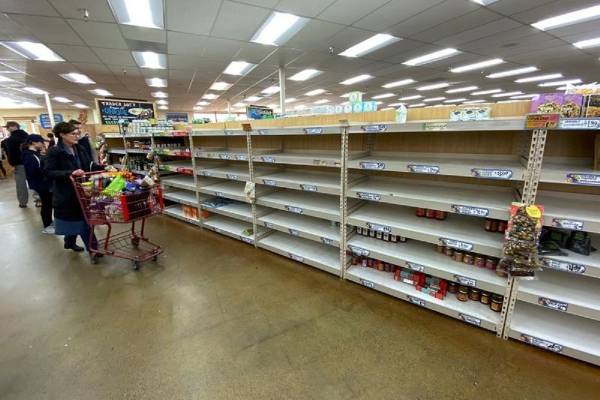U.S. grocery deficiencies extend as pandemic is the reason of supplies

Popularity for basic food items joined with taking off cargo expenses and Omicron-related work deficiencies are making a new round of excesses at handled food and new produce organizations, prompting void general store racks at significant retailers across the United States.
Supermarkets across the United States are seeing void retires that once held items going from bread to create to meat, as a flood in COVID-19 cases because of the Omicron variation adds one more layer of difficulty to a framework previously stressed by production network issues and specialist deficiencies.
Cultivators of transitory produce across the West Coast are paying almost triple pre-pandemic shipping rates to transport things like lettuce and berries before they ruin. Shay Myers, CEO of Owyhee Produce, which develops onions, watermelons and asparagus along the boundary of Idaho and Oregon, said he has been holding off transportation onions to retail wholesalers until cargo costs go down.
While the sparser choice might be suggestive of spring 2020, when tissue and cleaning supplies were rare, there are extra issues at play this time around, industry associations and specialists said. Almost two years into the pandemic, tangles in the production network proceed, however laborer nonappearances because of the wide reach of Omicron have assumed a huge part in the deficiency of merchandise at stores.
Myers said transportation disturbances over the most recent three weeks, brought about by an absence of transporters and late parkway impeding tempests, have prompted a multiplying of cargo costs for products of the soil makers, on top of as of now raised pandemic costs. “We regularly will send, East Coast to West Coast – we used to do it for about $7,000,” he said. “Today it’s somewhere close to $18,000 and $22,000.”
“Omicron non-attendance is by a wide margin the greatest driving component behind this,” said Katie Denis, VP of exploration and industry account at the Consumer Brands Association. “On the off chance that you don’t have individuals to make the items, transport the items, convey and stock the items, you will be in a tough spot with what appears on store racks.”
Higher frozen vegetables creator Conagra Brands’ (CAG.N) CEO Sean Connolly told financial backers last week that provisions from its U.S. plants could be obliged for at minimum the following month because of Omicron-related nonattendances.
Supermarkets regularly have around 7 to 10 percent of their things unavailable, Denis said. Yet, presently, it’s running at around 12% for all items. Also, it’s much higher for food and beverages, around 15% – possibly twofold how much things that are regularly inaccessible.
Recently, Albertsons (ACI.N) CEO Vivek Sankaran said he expects the grocery store chain to go up against more production network difficulties throughout the following four to about a month and a half as Omicron has invested a gouge in its endeavors to plug store network holes.
“These are larger numbers than we have seen all through the vast majority of the pandemic,” Denis said.
At Stop and Shop in Jamaica Plain on Friday, produce was very much loaded. In any case, there were restricted selections of meats, like pork and hamburger, and deficiencies of bundled products including cooking oil, tortillas, and filtered water.
Tommy Tornburg, 50, a Jamaica Plain occupant, said that he experiences as of late experienced issues tracking down bundled things, explicitly frozen food.
Customers via online media whined of void pasta and meat walkways at some Walmart (WMT.N) stores; a Meijer store in Indianapolis was cleared uncovered of chicken; a Publix in Palm Beach, Florida was out of toilet paper and home cleanliness items while Costco (COST.O) reestablished buy limits on bathroom tissue at certain stores in Washington state.
“At the point when COVID initially kicked in with regards to eighteen months prior, you were unable to get bathroom tissue, things like that,” he said. “Well that is there, yet you can’t get a great deal of food things and things like that, particularly bundled.”
The circumstance isn’t relied upon to lessen for no less than a couple of more weeks, Katie Denis, VP of interchanges and exploration at the Consumer Brands Association said, pinning the deficiencies on a shortage of work.
Stop and Shop said in an explanation that its business sectors, as other supermarkets, are considering item deficiencies to be providers battle with work and transportation challenges because of COVID.
“The Omicron variation, pair with ongoing climate interruptions, have exacerbated these holes and the effect is felt across the basic food item industry,” a representative said in an email.
The shopper bundled merchandise industry is absent around 120,000 specialists out of which just 1,500 positions were added last month, she said, while the National Grocer’s Association said that a large number of its supermarket individuals were working with under half of their labor force limit.
Jessica Dankert, VP of production network for the Retail Industry Leaders Association, said the things that are inaccessible appear to run the range and are “continually developing.”
“You might go to a store one day and not have the option to observe item X, you return in a little while and it’s completely loaded,” Dankert said. “It’s sort of a moving objective as far as where you’re seeing the effects.”
U.S. retailers are presently confronting generally 12% unavailable levels on food, refreshments, family cleaning and individual cleanliness items contrasted with 7-10% in normal occasions.
The issue is more intense with food items where unavailable levels are running at 15%, the Consumer Brands Association said.
SpartanNash, a U.S. staple wholesaler, last week said it has become more diligently to get supplies from food producers, particularly handled things like cereal and soup.
Supermarkets have changed in accordance with a gauge level of production network interruption all through the pandemic. However, the option of winter storms, special times of year, and Omicron have added a layer of clog, Dankert said. There’s additionally been an overall expansion in customer interest for food, all things considered, as more individuals invest energy at home because of the COVID flood.
Specialists said all aspects of the inventory network is encountering issues: deficiencies of materials expected to make the merchandise, the laborers delivering them, the transportation of the items to the stores, and the stocking of racks inside the stores. In October 2021, the American Trucking Association announced a deficiency of in excess of 80,000 drivers, a “noteworthy high” for the business. The National Grocers Association noticed a new overview showed a few stores working with less than 50% of their typical labor force at certain periods during the pandemic.
Michael Klein, a teacher of global monetary issues at Tufts University, noticed that costs have risen all the more intensely for explicit areas, like meats, poultry, fish, and eggs, which expanded by 12.5 percent throughout the most recent year, as per the Bureau of Labor Statistics. The way that meat costs have gone up more than different classes of staple things follows the way that positions in the meat business have been more hard to fill.
Customers have kept on loading up on food as they dig in at home to check the spread of the Omicron-variation. Denis said request throughout the most recent five months has been as high or higher than it had been in March 2020 toward the start of the pandemic. Comparable issues are being seen in different areas of the planet.
“That lines up with the clarification that meat-pressing spots can’t fill occupations, while there are not a similar sort of work supply issues for dairy,” Klein said.
At Star Market in Quincy on Friday, Brenda Lessard, 57, a previous worker of the market, said she normally takes care of her canine with chicken drumsticks. In the wake of seeing the cost had expanded to $7 for a pack of six, she picked not to get them.
In Australia, staple chain administrator Woolworths Group , said last week that over 20% of representatives at its circulation focuses are off work due to COVID-19. In the stores, the infection has put essentially 10% of staff down and out.
While cultivators with short-lived produce are compelled to pay expanded delivery rates to draw in restricted shipping supplies, makers like Myers are deciding to trust that excesses will ease.
Disclaimer: The views, suggestions, and opinions expressed here are the sole responsibility of the experts. No THE CASH WORLD journalist was involved in the writing and production of this article.






